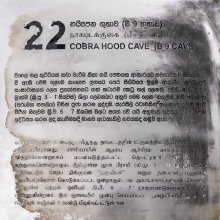Kada, Kadā, Kaḍa, Ka-da: 19 definitions
Introduction:
Kada means something in Hinduism, Sanskrit, Buddhism, Pali, the history of ancient India, Marathi, Jainism, Prakrit, Hindi, biology. If you want to know the exact meaning, history, etymology or English translation of this term then check out the descriptions on this page. Add your comment or reference to a book if you want to contribute to this summary article.
Images (photo gallery)
In Hinduism
Purana and Itihasa (epic history)
Source: Cologne Digital Sanskrit Dictionaries: The Purana IndexKaḍa (कड).—A brother of Vasudeva.*
- * Vāyu-purāṇa 96. 148.

The Purana (पुराण, purāṇas) refers to Sanskrit literature preserving ancient India’s vast cultural history, including historical legends, religious ceremonies, various arts and sciences. The eighteen mahapuranas total over 400,000 shlokas (metrical couplets) and date to at least several centuries BCE.
India history and geography
Source: archive.org: Glossary of Sinhalese Folk Terms appearing in the Service Tenure RegisterKada:—A load divided into two portions of equal weight and tied to the two ends of a pole, which is balanced on the shoulder, called in Ceylon a ‘‘ pingo ” and in India a “ bhangy.”

The history of India traces the identification of countries, villages, towns and other regions of India, as well as mythology, zoology, royal dynasties, rulers, tribes, local festivities and traditions and regional languages. Ancient India enjoyed religious freedom and encourages the path of Dharma, a concept common to Buddhism, Hinduism, and Jainism.
Biology (plants and animals)
Source: Google Books: CRC World Dictionary (Regional names)1) Kada in India is the name of a plant defined with Grewia tiliaefolia in various botanical sources. This page contains potential references in Ayurveda, modern medicine, and other folk traditions or local practices It has the synonym Grewia tiliifolia Vahl, nom. illeg. (among others).
2) Kada is also identified with Xylia xylocarpa It has the synonym Acacia xylocarpa (Roxb.) Willd. (etc.).
3) Kada in Kenya is also identified with Syzygium guineense It has the synonym Calyptranthes guineensis Willd. (etc.).
Example references for further research on medicinal uses or toxicity (see latin names for full list):
· Plants of the Coast of Coromandel (1795)
· Prodromus Systematis Naturalis Regni Vegetabilis (1828)
· Wissenschaftliche Ergebnisse der Deutschen Zentral-Afrika-Expedition 1907–1908, Botanik (1907)
· Species Plantarum.
· Journal of Tree Sciences (1982)
· Journal of Ethnopharmacology (2005)
If you are looking for specific details regarding Kada, for example health benefits, pregnancy safety, chemical composition, side effects, extract dosage, diet and recipes, have a look at these references.

This sections includes definitions from the five kingdoms of living things: Animals, Plants, Fungi, Protists and Monera. It will include both the official binomial nomenclature (scientific names usually in Latin) as well as regional spellings and variants.
Languages of India and abroad
Pali-English dictionary
Source: BuddhaSasana: Concise Pali-English Dictionarykadā : (adv.) when?
Source: Sutta: The Pali Text Society's Pali-English DictionaryKadā, (indecl.) (Vedic kadā. Cp. tadā, sadā in Pali, and perhaps Latin quando). interr. adv. when? (very often foll. by fut.) Th. 1, 1091—1106; J. II, 212; VI, 46; DhA. I, 33; PvA. 2.—combined with —ssu J. V, 103, 215; VI, 49 sq. —ci (cid) indef.—1. at some time A. IV, 101.—2. sometimes J. I, 98; PvA. 271.—3. once upon a time Dāvs. I, 30.—4. perhaps, may be J. I, 297; VI, 364. + eva: kadācideva VvA. 213; —kadāci kadāci from time to time, every now and then J. I, 216; IV, 120; DhsA. 238; PvA. 253. —kadāci karahaci at some time or other, at times A. I, 179; Miln. 73; DhA. III, 362. —na kadāci at no time, never S. I, 66; J. V, 434; VI, 363; same with mā k° J. VI, 310; Mhvs 25, 113; cp. kudācana.—kadāc‹-› —uppattika (adj.) happening only sometimes, occasional Miln. 114. (Page 185)

Pali is the language of the Tipiṭaka, which is the sacred canon of Theravāda Buddhism and contains much of the Buddha’s speech. Closeley related to Sanskrit, both languages are used interchangeably between religions.
Marathi-English dictionary
Source: DDSA: The Molesworth Marathi and English Dictionarykaḍa (कड).—f (kaṭa S) The hollow above the hip, the flank. 2 The outer part, edge, verge, border, brink, margin. 3 A quarter, region, direction. Used in obl. cases, as hyākaḍēsa, tyākaḍēsa, ikaḍē, tikaḍē, ikaḍacā, tikaḍacā, ikaḍūna, tikaḍūna. 4 A sort of soft sandstone.
--- OR ---
kaḍa (कड).—m R (Commonly kaḍha) Ebullition &c.
--- OR ---
kaḍā (कडा).—m (kaḍa) A cliff or precipice. v tuṭa. Ex. ṛṣēśvara paḷati sakaḷa || kaḍē vēṅgati parvatācē ||
--- OR ---
kada (कद).—m A sort of silk cloth for dhotars. It is without kāṭha or border. See pitāmbara. 2 Thickness; i.e. substance, solidity, quantity of material or degree of density. Ex. hiṛyācā kada jasa jasā pātaḷa tasataśī tyācī kimmata adhika.
--- OR ---
kada (कद).—( A Stature.) A misunderstood and misused word. Value, virtue, goodness, excellency, qualification. Ex. tujhā kāya kada majaśīṃ vāda karā- yālā or majapuḍhēṃ bōlāyālā? 2 The dividing piece or running stitch betwixt the two sides of a gōṇī or packsack.
--- OR ---
kadā (कदा).—ad S When, at what time?
--- OR ---
kāḍa (काड).—n f Thrashed or trodden stalks of leguminous plants, pulse-straw. 2 f Straw (of wheat, nācaṇī, uḍīda, varī and others). 3 C The chaff and bits that fall from rice-straw on beating or shaking it. 4 C Plants of rice left over from a transplantation. 5 Peeled stalks of ambāḍī or tāga. 6 n Legumes gen.
--- OR ---
kāḍā (काडा).—m C Milk-bush, Euphorbia tirucalli.
Source: DDSA: The Aryabhusan school dictionary, Marathi-Englishkaḍa (कड).—f The margin. A region. kaḍa dharaṇēṃ To espouse the side of. m Ebullition.
--- OR ---
kaḍā (कडा).—m A precipice, cliff.
--- OR ---
kada (कद).—f Stature. Mettle, virtue. kada jiraviṇēṃ To take the conceit out of.
--- OR ---
kadā (कदा).—ad When ? At what time?
--- OR ---
kāḍa (काड).—n f Pulse-straw. f Straw.
Marathi is an Indo-European language having over 70 million native speakers people in (predominantly) Maharashtra India. Marathi, like many other Indo-Aryan languages, evolved from early forms of Prakrit, which itself is a subset of Sanskrit, one of the most ancient languages of the world.
Sanskrit dictionary
Source: DDSA: The practical Sanskrit-English dictionaryKaḍa (कड).—a.
1) Dumb.
2) Hoarse.
3) Ignorant, foolish.
--- OR ---
Kadā (कदा).—ind. When, at what time; कदा गमिष्यसि-एष गच्छामि (kadā gamiṣyasi-eṣa gacchāmi); कदा कथयिष्यसि (kadā kathayiṣyasi) &c.; when connected with a following अपि (api) it means 'now and then', 'at times', 'sometimes', 'at some time'; न कदापि (na kadāpi) never; with a following चन (cana) it means 'at some time', 'one day', 'at one time or another', 'once'; आनन्दं ब्रह्मणो विद्वान्न विभेति कदाचन (ānandaṃ brahmaṇo vidvānna vibheti kadācana); Manusmṛti 2.54,144;3.25,11; with a following चित् (cit) it means 'at one time', 'once upon a time', 'at some time or other'; अथ कदाचित् (atha kadācit) once upon a time; R.2.37,12.21; नाक्षैः क्रीडेत्कदाचित्तु (nākṣaiḥ krīḍetkadācittu) Manusmṛti 4.74,65,169; कदाचित्-कदाचित् (kadācit-kadācit) 'now-now'; कदाचित् काननं जगाहे कदाचित् कमलवनेषु रेमे (kadācit kānanaṃ jagāhe kadācit kamalavaneṣu reme) K.58 et seq. [cf. L. quando].
--- OR ---
Kada (कद).—a cloud (giving water).
Derivable forms: kadaḥ (कदः).
Kada is a Sanskrit compound consisting of the terms ka and da (द).
Source: Cologne Digital Sanskrit Dictionaries: Edgerton Buddhist Hybrid Sanskrit DictionaryKāḍa (काड).—adj. (= Pali kāḷa, Sanskrit kāla), black: [Prātimokṣasūtra des Sarvāstivādins] 496.6. See next.
Source: Cologne Digital Sanskrit Dictionaries: Shabda-Sagara Sanskrit-English DictionaryKaḍa (कड).—mfn.
(-ḍaḥ-ḍā-ḍaṃ) Ignorant, stupid. E. kaḍ to be perplexed, ac aff.
--- OR ---
Kada (कद).—or (i) kadi r. 1st. cl. (kadate and kandate) 1. To be confused, to suffer mentally, to grieve. 2. To confound. 3. To kill or hurt; also kadi (kaṃdati) 1. To call. 2. To cry or shed tears.
--- OR ---
Kada (कद).—m.
(-daḥ) A cloud. E. ka water, rnd da what gives.
--- OR ---
Kadā (कदा).—ind. When, at what time. E. kim what, dā aff.
Source: Cologne Digital Sanskrit Dictionaries: Benfey Sanskrit-English DictionaryKadā (कदा).—[ka + dā] (see kim), adv. At what time, [Nala] 22, 7. With following cana, 1. Once, some time; preceded by na, Never, [Mānavadharmaśāstra] 2, 58. 2. Perhaps, [Pañcatantra] 22, 10. With following cid, Once, [Brāhmaṇavilāpa] 1, 2; preceded by na, Never, [Mānavadharmaśāstra] 4, 74. 3. Followed by api, and preceded by na, Never, [Hitopadeśa] 58, 12.
— Cf. [Latin] quando, quandoque = kāda cid.
Source: Cologne Digital Sanskrit Dictionaries: Cappeller Sanskrit-English DictionaryKaḍa (कड).—[adjective] dumb.
--- OR ---
Kadā (कदा).—[adverb] when? at what time? how? With na never; [with] cana the same or at some time, once; [with] cid some time or other, sometimes, perhaps; [with] api (later) at any time, always, ever. kadā cid, kadā cidapi, & kadāpi [with] na never.
Source: Cologne Digital Sanskrit Dictionaries: Monier-Williams Sanskrit-English Dictionary1) Kada (कद):—[=ka-da] [from ka] a m. ‘water-giver’, a cloud, [cf. Lexicographers, esp. such as amarasiṃha, halāyudha, hemacandra, etc.]
2) Kaḍa (कड):—[from kaḍ] mfn. dumb, mute, [Śatapatha-brāhmaṇa xiv]
3) [v.s. ...] ignorant, stupid, [cf. Lexicographers, esp. such as amarasiṃha, halāyudha, hemacandra, etc.]
4) Kada (कद):—[=ka-da] b See 3. ka.
5) Kadā (कदा):—ind. ([from] 2. ka), when? at what time? (with following [future] or [present tense] tense, [Pāṇini 3-3, 5]), [Ṛg-veda; Mahābhārata; Pañcatantra] etc.
6) at some time, one day, [Ṛg-veda viii, 5, 22]
7) how? [Ṛg-veda vii, 29, 3]
8) with a following nu khalu, when about ? [Mahābhārata iii]
9) with a following ca and preceding yadā, whenever, as often as possible (e.g. yadā kadā ca sunavāma somam, let us press out the Soma as often as may be or at all times, [Ṛg-veda iii, 53, 4])
10) with a following cana, never at any time, [Ṛg-veda; Atharva-veda; Taittirīya-upaniṣad; Hitopadeśa] etc.
11) ([irregular] also) at some time, one day, once, [Mahābhārata xiii; Kathāsaritsāgara] etc.
12) na kadā, never, [Ṛg-veda vi, 21, 3; Subhāṣitāvali]
13) na kadā cana, never at any time, [Ṛg-veda; Atharva-veda etc.]
14) kadā cit, at some time or other, sometimes, once
15) na kadā cit, never
16) kadāpi, sometimes, now and then
17) na kadāpi, never;
18) cf. [Zend] kadha; [Greek] κότε and πότε; [Latin] quando; [Lithuanian] kadá; [Slavonic or Slavonian] kŭda.
Source: Cologne Digital Sanskrit Dictionaries: Yates Sanskrit-English Dictionary1) Kaḍa (कड):—[(ḍaḥ-ḍā-ḍaṃ) a.] Ignorant.
2) Kada (कद):—(daḥ) 1. m. A cloud.
3) Kadā (कदा):—adv. When, at what time.
Source: DDSA: Paia-sadda-mahannavo; a comprehensive Prakrit Hindi dictionary (S)Kadā (कदा) in the Sanskrit language is related to the Prakrit words: Kai, Kaiā, Kayā, Kāhe.
[Sanskrit to German]
Sanskrit, also spelled संस्कृतम् (saṃskṛtam), is an ancient language of India commonly seen as the grandmother of the Indo-European language family (even English!). Closely allied with Prakrit and Pali, Sanskrit is more exhaustive in both grammar and terms and has the most extensive collection of literature in the world, greatly surpassing its sister-languages Greek and Latin.
Hindi dictionary
Source: DDSA: A practical Hindi-English dictionary1) Kaḍā (कडा):—(a) hard; strict; stiff; harsh, cruel; arduous; sharp; rigid; strong; (nm) a bangle, metal ring; ~[ī/~pana] stiffness; hardness; harshness; strictness; sharpness; rigidity; —[mijāja] stiff/harsh/stern nature; —[paḍanā] to adopt a stiff attitude, to become stern; hence [kaḍī] (fem.).
2) Kada (कद) [Also spelled kad]:—(nm) size; height; —[kāṭhī] stature; figure and frame; [kadokāmata] stature, figure and frame.
...
Prakrit-English dictionary
Source: DDSA: Paia-sadda-mahannavo; a comprehensive Prakrit Hindi dictionary1) Kaḍa (कड) in the Prakrit language is related to the Sanskrit word: Kaṭa.
2) Kaḍa (कड) also relates to the Sanskrit word: Kṛta.
Prakrit is an ancient language closely associated with both Pali and Sanskrit. Jain literature is often composed in this language or sub-dialects, such as the Agamas and their commentaries which are written in Ardhamagadhi and Maharashtri Prakrit. The earliest extant texts can be dated to as early as the 4th century BCE although core portions might be older.
Kannada-English dictionary
Source: Alar: Kannada-English corpusKaḍa (ಕಡ):—
1) [noun] something lent, esp. a sum of money to be returned; a loan; the thing or money loaned.
2) [noun] ಕಡ ಹುಟ್ಟಿ ಬಡವ ಕೆಟ್ಟ [kada hutti badava ketta] kaḍa huṭṭi baḍava keṭṭa hewho goes a borrowing goes a sorrowing; ಕಡ ಸಿಕ್ಕುವುದಾದರೆ, ಹಡಗೇ ನನಗಿರಲಿ [kada sikkuvudadare, hadage nanagirali] kaḍa sikkuvudādare, haḍagē nanagirali borrowing tempts one to be always acquisitive.
--- OR ---
Kaḍa (ಕಡ):—[noun] a shallow place in a stream, river, etc., where one can cross; a ford; a place or route of carriage over water; the place where a ferry docks on either shore; a ferry.
--- OR ---
Kaḍa (ಕಡ):—[noun] a largedeer (Cervus unicolor) with coarse hair, a short, erectile mane, and three-pointed antlers; an Indian sambar.
--- OR ---
Kaḍa (ಕಡ):—
1) [noun] a stretch of rising land at the edge of a body of water, esp. a river.
2) [noun] a basin at the bottom of a tree or a levelled wet agricultural land with raised mound on all sides, for holding water.
--- OR ---
Kaḍa (ಕಡ):—
1) [noun] a flat, coarse fabric made of straw used as a floor covering or sitting on; a straw mat.
2) [noun] the outskirts of a city or a town.
3) [noun] a time; period of time; a season.
4) [noun] the hip and loins; the hollow above the hips.
5) [noun] the fleshy side of a person or animal between the ribs and the hip; the flank.
6) [noun] a dead of a person; corpse.
7) [noun] a place for the burial or cremation of the dead bodies; a cemetry; a crematory.
8) [noun] a portable framework on which a corpse is carried.
9) [noun] a long, broad, thick wooden board; a plank.
10) [noun] a plant lasting or living only one year or season.
11) [noun] The grass Saccharum sara (= S. munja) of Poaceae family.
12) [noun] plentifulness; bountifulness; excessiveness; abundance.
13) [noun] either of the flat surfaces alongside the forehead, in front of each ear of an elephant; the temples.
14) [noun] either of the two bones or bony parts that hold the teeth and frame the mouth in most vertebrates; the jaw.
15) [noun] a pointed straight missile to be shot from a bow; an arrow.
16) [noun] a social convention carried on by tradition and enforced by social disapproval of any violation; a ustom.
17) [noun] the fine, dustlike mass of grains that are produced in the anthers or microspore sacs of seed plants, containing the male sexual cells (gametophytes) of the plant; pollen.
--- OR ---
Kada (ಕದ):—
1) [noun] a movable structure for opening or closing an entrance, as to a building or room, that usu. turns on hinges; a door.
2) [noun] ಕದ ತಿನ್ನುವವನಿಗೆ ಹಪ್ಪಳ ಈಡೆ [kada tinnuvavanige happala ide]? kada tinnuvavanige happaḷa īḍe? hewho has eaten up a vat asks for the pipkin; ಕದ ತಿನ್ನುವವರ ಮನೆಯಲ್ಲಿ ಹಪ್ಪಳ ಬಾಳುವುದೇ [kada tinnuvavara maneyalli happala baluvude]? kada tinnuvavara maneyalli happaḷa bāḷuvudē? = ಕದ ತಿನ್ನುವವನಿಗೆ ಹಪ್ಪಳ ಈಡೆ [kada tinnuvavanige happala ide]?
--- OR ---
Kada (ಕದ):—[noun] a visible mass of condensed watery vapour floating in the atmosphere high above the general level of the ground; a cloud.
--- OR ---
Kāḍa (ಕಾಡ):—
1) [noun] a man dwelling in a forest; a forest-dweller.
2) [noun] an unrefined, uncultured or uncivilised man.
--- OR ---
Kāḍa (ಕಾಡ):—[noun] the colour of charcoal; black colour.
Kannada is a Dravidian language (as opposed to the Indo-European language family) mainly spoken in the southwestern region of India.
See also (Relevant definitions)
Starts with (+1110): Kada jara, Kada jhemudu, Kada Jiravinem, Kada Odhanem, Kada-anthrinta, Kada-aparadha, Kada-aviya, Kada-hakukare, Kada-jemudu, Kada-Kana-Kara-Dishi-Dini, Kada-khantudi, Kada-nakkare, Kada-narollgi, Kada-nivali, Kada-pani, Kada-rajakariya, Kada-todali, Kadaaga, Kadaani, Kadaani mara.
Ends with (+265): Accukkada, Adamakada, Adhekada, Adukku-walankada, Agakada, Aikkada, Akada, Akkada, Akkata, Allikada, Alokada, Amgikada, Amkada, Anaikata, Anisakada, Anissakada, Ankada, Appekada, Arekada, Asokada.
Full-text (+274): Kadam, Kai, Kadamkara, Yada, Kadamgara, Kadamgariya, Kad, Kadapi, Kadama, Katamai, Apalasin, Tarua kadam, Kadam kapoor, Tarwa kadam, Bhui kadam, Kadamkariya, Mir-kadam-phuli, Akalakara-Kara-Kada-Kadha, Kada Jiravinem, Kadasari.
Relevant text
Search found 45 books and stories containing Kada, Kadā, Kaḍa, Kaḍā, Kāḍa, Kāḍā, Ka-da; (plurals include: Kadas, Kadās, Kaḍas, Kaḍās, Kāḍas, Kāḍās, das). You can also click to the full overview containing English textual excerpts. Below are direct links for the most relevant articles:
Garga Samhita (English) (by Danavir Goswami)
Verse 5.17.11 < [Chapter 17 - The Gopis Describe Their Remembrance of Sri Krsna]
Verse 5.17.17 < [Chapter 17 - The Gopis Describe Their Remembrance of Sri Krsna]
Verse 2.1.19 < [Chapter 1 - Description of the Entrance in Vṛndāvana]
Yogadrstisamuccaya of Haribhadra Suri (Study) (by Riddhi J. Shah)
Chapter 5.6 - The three types of Understanding: Budhi, Jñāna, Asaṃmoha < [Chapter 5 - A Line of Demarcation between the first four and last four Yogadṛṣṭis]
Rig Veda (translation and commentary) (by H. H. Wilson)
Temples in and around Madurantakam (by B. Mekala)
Tiruvenkateswarar Temple—Kadapperi < [Chapter 4 - Prominent Temples in Madurantakam Taluk]
Sahitya-kaumudi by Baladeva Vidyabhushana (by Gaurapada Dāsa)


